The Bird Life
There are an estimated 8,600 species of birds worldwide, and of these over 1,200, or about 14%, may be found in the Indian subcontinent. A visit to an Indian national park, therefore, may be unusually rewarding for the bird enthusiast. Checklists are available for several of the most popular national parks in India, including Corbett, Bandhavgarh, and Ranthambhore, as well as for Nepal’s Royal Chitwan. Unfortunately, there is no current, official checklist of the birds of Kanha published by the park. However, during the 1980s Park Research Officer P. C. Kotwal compiled a list of 163 species together with rather scanty annotations. This document is available for public inspection at the Kanha Museum. Curiously, H. S. Panwar devoted only two pages to the birdlife of Kanha in his Kanha National Park: A Handbook (1991). In 1986, Paul Newton, Stanley Breeden, and Guy J. Norman published a more fully annotated listing: see “The Birds of Kanha Tiger Reserve, Madhya Pradesh, India” in Journal of the Bombay Natural History Society 83 (1986) 477-498. This list, based on observations made between January 1980 and July 1983, included 225 species, a total that the authors regarded as aln10st certainly an underestimate. This article still offers useful information.
The Kanha Museum contains a large wall display showing 64 “common birds of Kanha.” Although the birds are generally well illustrated, some of them are sighted relatively rarely in the park: for example, the Nakta or Comb Duck (Sarkidiornis melanotos), the Long-billed Vulture (Gyps indicus), the Yellow-wattled Lapwing (Vanellus malabaricus), and the Blue-tailed Bee-eater (Merops philippinus). Other species, which are relatively common and certainly notable for birdwatchers, are omitted on this list: for example, the Blackwinged Kite (Elanus caeruleus), the Crested Hawk-Eagle (Spizaetus cirrhatus), and the Shikra (Accipiter badius). As of mid-1999, E. P. Eric D’Cunha and Rashid Ali are planning the publication of an updated, annotated list in the Journal of the BNHS, which will include in excess of 235 species for the core area of Kanha as well as the buffer zone.
As these numbers suggest, by the standards of Indian national parks Kanha offers a substantial range of avifauna: for example, at least 52 of the 77 families of Indian birds are represented here. Nevertheless, the park cannot match the riChes of Corbett or Nepal’s Royal Chitwan, each of which boasts well over 400 species. For the sake of a comparison closer to home, Hashim Tyabji’s checklist for the birds in nearby Bandhavgarh National Park, published in 1994, totals 242 species. The standard field guide for birders is now the twelfth edition of Salim Ali’s The Book of Indian Birds (1996). This classic reference work, which was first published in 1941, now includes illustrations and descriptions of 538 species (vs. only 296 species in the previous edition). Another helpful field guide is the Collins Handguide to the Birds of the Indian Subcontinent by Martin Woodcock (1980). Also useful for its illustrations is Salim Ali and S. Dillon Ripley’s A Pictorial Guide to the Birds of the Indian Subcontinent (second, updated edition, 1995). Specialists may consult the same authors’ definitive ten-volume work, Handbook of the Birds of India and Pakistan (1968-74).
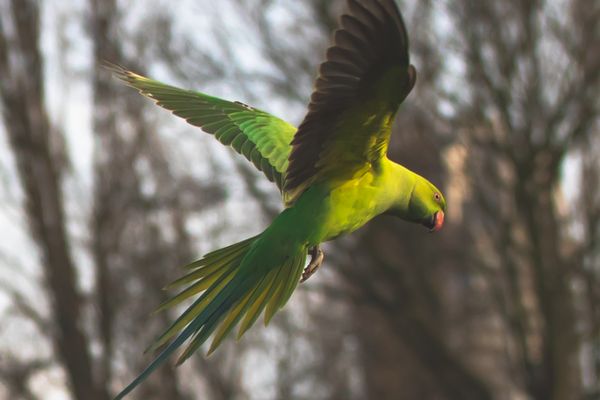
What can the Birdwatcher expect at Kanha?
Obviously, numbers and variety will differ with the time of year, but our experience suggests that a fortnight’s visit should easily yield on the order of 100 species. For a comprehensive listing and detailed annotation, we eagerly await the reference work currently being prepared by D’Cunha and All. Meanwhile, we have selected forty species for brief treatment here. These “top 40” were chosen on the following criteria: the birds are sighted relatively frequently at Kanha; they represent a diversity of habitats within the park; and various features of their appearance, behaviour, and/or calls make them intrinsically interesting.
Purple Heron
( Ardea purpurea )
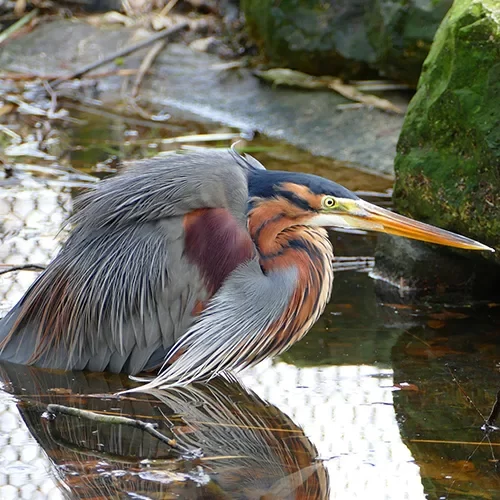
This is a middle-sized heron, coloured blue-gray above with black and brown underparts. The head and neck are rufous, black, and white, and the bill is yellow. The bird’s common name comes from its purple appearance in bright sunlight. The purple heron feeds on fish, frogs, and snakes; it is largely solitary. Shravan Tal and Sondhar Tank are good places to look for this species.
Shikra
(Accipiter badius)
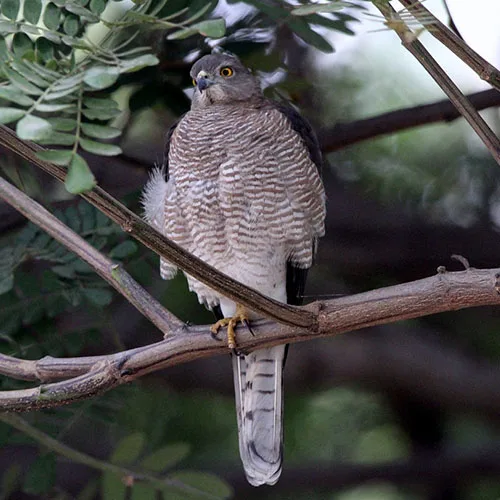
In contrast to the Blackwinged Kite, the Shikra prefers wooded habitat. About the size of a pigeon, the male Shikra is blue-gray above and white below, with brown crossbars. The tail is barred with black. The female is browner in colour and larger in size, as is often the case with raptors. At Kanha, you m~y look for the Shikra in sal forest or mixed sal and bamboo habitat. This bird is quite commonly seen flying low across the road or perched sufficiently low that photography is possible despite the Shikra’s small size.
Paddy Bird or Pond Heron
(Ardeola grayii)
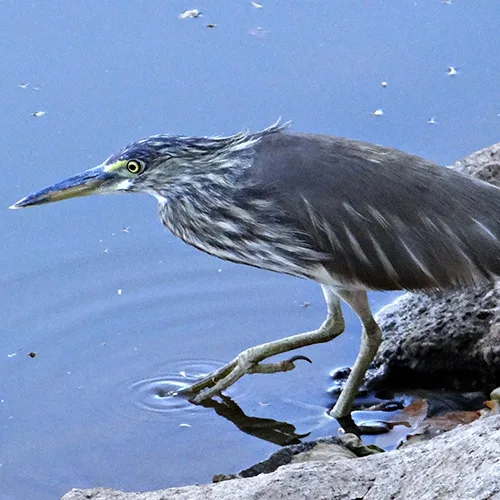
This heron, which approximates the size of the Little Egret, is one of the most common marsh species in Kanha. It is delightfully varied in appearance: rather drab and speckled brown when on the ground or at rest, but flashing white when in flight. This heron feeds on frogs, crabs, fish, and insects, which it finds either while waiting patiently at the edge of the shallows or by wading slowly through the water and keenly watching for the slightest movement. Nakti Ghati, Shravan Tal, and Sondhar Tank are all good places for sightings. These herons are sometimes seen singly, sometimes in pairs or small groups of 3-5.
White-eyed Buzzard
(Butastur teesa)
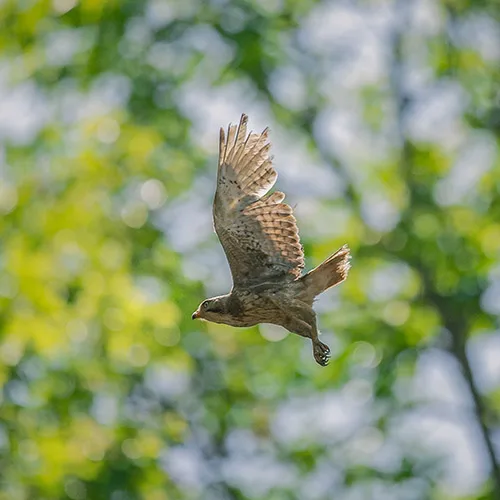
This bird of prey, which is larger than the Blackwinged Kite, is about the size of a Jungle Crow. It is much darker in colour and significantly smaller than the other commonly seen buzzard of Kanha, the Honey Buzzard (Pernis ptilorhyncus). The White-eyed Buzzard has a conspicuous white throat patch and prominent white or yellowishwhite eyes. Like the Blackwinged Kite, it favours dry, open areas and competes for the same prey, including lizards, locusts, grasshoppers, crickets, and mice. Places to look for the White-eyed Buzzard include Kanha Meadow and the open areas south of the Sulcum bridge on Sijhora Road. The species is sometimes attracted to areas where controlled grass burning is in progress because large numbers of insects are flushed out.
ENQUIRE NOW
Lets plan your safari tour. Please fill the enquiry form below and our team will get back to you within 24 hours with a perfect safari package.






